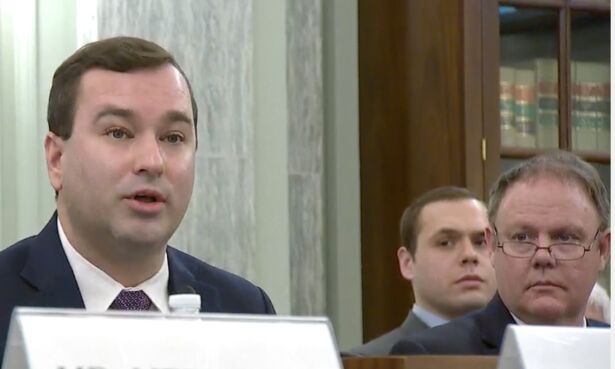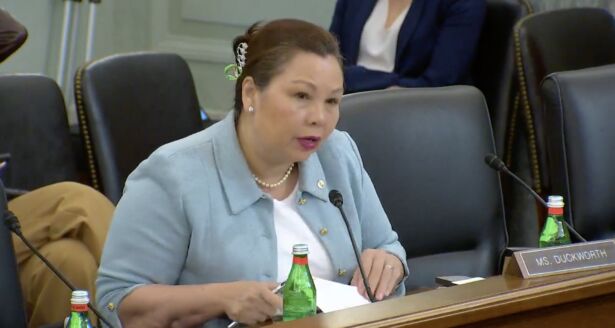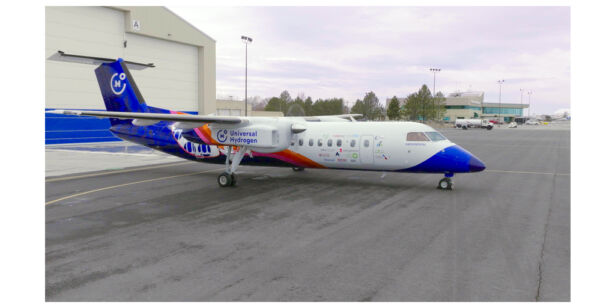The American aviation sector is abuzz with talk of air taxis, hypersonic airplanes, and cheaper, cleaner, “sustainable” fuel sources.
But a cloud hovers over that sunny, futuristic forecast. The Federal Aviation Administration (FAA) remains woefully behind the technology curve. The agency also remains entangled in its own bureaucratic web, according to statements made during a U.S. Senate committee hearing on March 29.
The Senate Committee on Commerce, Science, and Transportation held the “Advancing Next-Generation Aviation Technologies” session in Washington. That session is part of congressional work on a five-year spending and policy plan for the FAA, called a “reauthorization.”
The committee’s latest hearing opened on an optimistic note. Its chair, U.S. Sen. Maria Cantwell (D-Wash.), said: “This is about winning a competitive race for the future … Today’s research will get Americans moving faster.”
She advocates tripling spending for research on “clean” energy sources for aviation.

Critique From Cruz
But Sen. Ted Cruz (R-Texas), the committee’s ranking member, struck a cautionary note.
He’s leery of spending taxpayer dollars to prop up emerging technologies. Cruz also doubts the FAA can support innovative new modes of travel. He said the agency is using outdated systems and cannot even handle existing users, let alone new ones.
“Right now, the air-traffic control system is essentially using technologies designed in the 1950s,” Cruz said. “It’s using radar technologies; it’s using little slips of paper … They’re not using GPS widely.”
Cruz also took a shot at Transportation Secretary Pete Buttigieg, who oversees the FAA.
“Just last week, Secretary Buttigieg asked airlines to cut their schedules in New York by 10 percent because the FAA couldn’t keep up with the traffic. That’s a failure of the job given to the department,” Cruz said.
The Epoch Times has sought comment from Buttigieg’s Department of Transportation.
Considering the FAA’s deficiencies, “it seems to me that many of these new technologies will hit a major roadblock if our air traffic system can’t handle the operations,” Cruz said.
‘Can’t Get Our Act Together’
Marc Scribner, a senior transportation policy analyst at the nonprofit Reason Foundation, said all of Cruz’s characterizations of the FAA were correct.
He said discussions about revamping the FAA started during the administration of President Bill Clinton, who served from 1983–2001.
But little progress seems to have been made since then because of “status quo bias” within the FAA, Scribner said.

Clearly frustrated by the FAA’s technology deficit, Cruz said, “What was once supposed to be a transformative upgrade to our air-traffic systems has become a tech-refresh effort, plagued by delays and cost overruns, with limited benefit to the flying public.”
He also cited another glaring problem at the FAA. Cruz said that companies seeking approval for new technologies get so frustrated that they leave the United States. They head for less-complex “regulatory sandboxes” in nations such as Australia or the United Kingdom.
One high-tech aviation company pulled up stakes after nine years of being hindered by the FAA, Scribner said.
“This is antithetical to America’s ethos of innovation,” Cruz said. “And it’s frankly embarrassing for businesses to be lost to other countries when we can’t get our act together.”
“We must hold the FAA accountable for its role in certifying new aircraft and its failure to give clear and consistent regulatory guidelines,” he said.
‘Sustainable’ May Be Costly
Cruz said there was a “profound” risk of wasting taxpayer dollars anytime government subsidies are provided.
“We’re already seeing this happening with sustainable aviation fuel, or SAF, in last year’s wasteful tax-and-spend reconciliation bill,” he said.
According to the U.S. Department of Energy, SAFs can be produced from crops such as corn, various “fats, oils, greases,” and even manure.
But SAF costs up to eight times more than traditional jet fuel, Cruz said. Few people could afford air travel if this added cost were shifted entirely to the flying public.
Yet, he said, “Congressional Democrats provided nearly $300 billion in grants and a special tax credit varying between $1.25 and $1.75 per gallon for the SAF. Without these government handouts, SAF would not be commercially viable.”
“ESG goals, driven by politics, should not be used to harm the American consumer,” Cruz said. “Our priorities in aviation must be safety, reliability, and affordability.
However, both Cantwell and the chair of the aviation subcommittee, Sen. Tammy Duckworth (D-Ill.), expressed continuing support of SAF. The two Democrats in the Democrat-controlled Senate expressed an opinion opposing that of their Republican colleague, Cruz.
“One of the most important things we can do to make American aviation more sustainable is increase American-grown, American-made” SAF, said Duckworth, a pilot.

“SAF presents an incredible opportunity to support a critical industry in our nation’s heartland,” she said. Farmers and “blenders” of the fuel benefit “while also reducing our carbon footprints across all modes of transportation.”
Cantwell also said that the aviation industry and the federal government have agreed to strive for “net-zero aviation emissions by 2050.”
Reaching that goal will require new fuels and “building aircraft made from lighter-weight thermoplastics and composites,” she said. More research is needed to develop and test those materials.
“We feel like we must seize on the opportunity with this FAA reauthorization to strengthen America’s competitiveness in aerospace,” Cantwell said.
Hydrogen on the Rise
Jon Gordon, a co-founder of California-based Universal Hydrogen, testified that there seems to be a fallacy surrounding SAF.
Those fuels “have a carbon footprint no better than the fossil fuels they displace,” he said. Yet hydrogen is still playing second fiddle to SAF in U.S. government agencies.
“This mindset is especially risky given that the EU, UK, and China are all developing hydrogen-powered aviation,” Gordon said.
Just weeks ago, three years after his company began, Universal Hydrogen “achieved the historic first flight” of a 40-passenger regional aircraft, he said.

“This is the largest aircraft ever to fly powered with a hydrogen fuel cell and the largest aircraft ever to fly principally on hydrogen,” Gordon said. “To some, the promise of emission-free flight may seem a distant vision. But I hope our first flight brings that reality to each of you.”
Interest among airlines for hydrogen fuel is high, he said. So far, 16 airlines in 12 countries have committed to purchasing more than 250 aircraft.
“Within a decade, you will see our hydrogen-powered aircraft flying in nearly every region of the globe,” Gordon predicted.
“Furthermore, we have made our hydrogen fuel tanks modular. This allows us to fill them up off-site,” he said, and then transport the tanks to an airport and load them on and off aircraft, “all with existing infrastructure.”
“Every airport in the world is now ready to support hydrogen-powered flight. We are on the verge of a revolution in how we power aircraft,” Gordon said.
“This is good for the economy as well as the environment. We must take the right steps now to ensure that the United States is prepared.”
‘Desperately Far Behind’
To achieve this, the FAA needs more resources to “ensure that the door to certification is only open to those upholding the highest safety standards.” He also suggested that government leaders must put hydrogen fuel on par with FAS. “At a recent aviation conference, participants were asked what technology will fuel the future of flight. The clear winner was hydrogen.”
Yet, he said, the recent White House report on national aeronautics priorities “dismisses” hydrogen-powered aviation and favors SAF.

Another change is needed, Gordon said. While he has spoken with various government agencies, “they listen with interest,” but “there is no follow-up.”
“No department, agency, or division is directed to focus on hydrogen aviation. If the U.S. is to remain a global leader in the future of aviation, then all relevant federal agencies must work together to create the proper safety certification and operational frameworks to ensure its success right now. We are desperately far behind.”
Gordon suggested that the U.S. follow Japan’s lead and establish a “hydrogen-hybrid and electric aviation task force,” separate from the “entrenched status quo interests who only see SAF as worthy of consideration.”
“Our industry faces a tipping point,” he said. “We must either innovate or fall behind.”
Another witness, Ben Lieberman, a senior fellow at the nonprofit Competitive Enterprise Institute, testified that Washington experts “are not as good as we think we are at identifying the next big thing.”
“The truth is we can’t know where the technology is headed and what the next breakthrough is, and how resources should best be allocated,” Lieberman said.
“That’s a process that’s best left to the free market rather than attempts at central planning.”
From The Epoch Times
